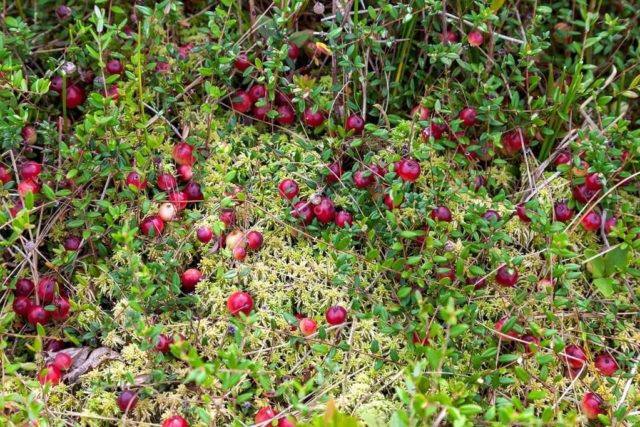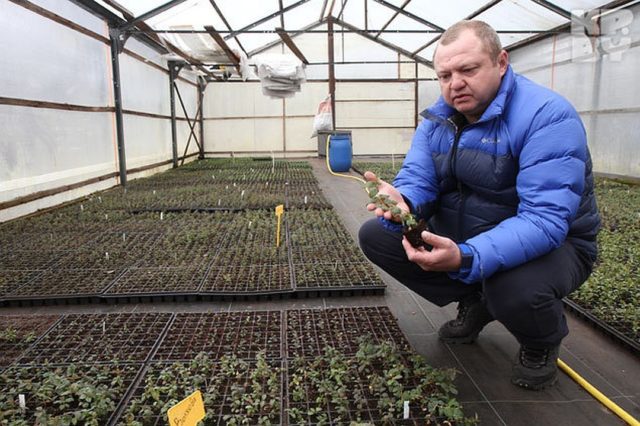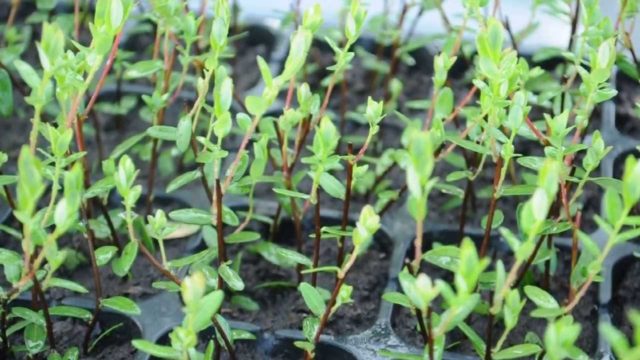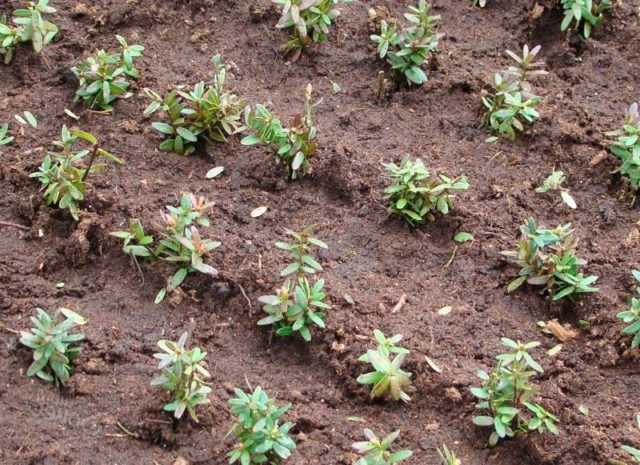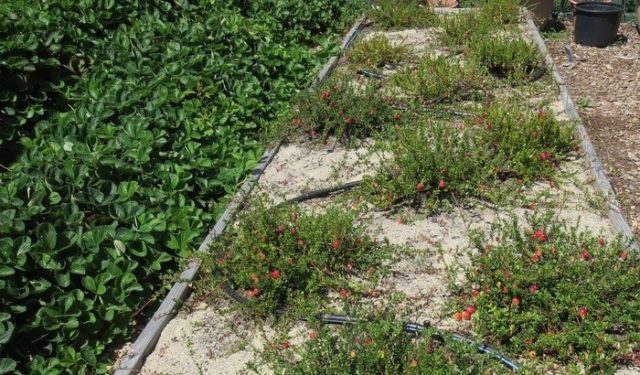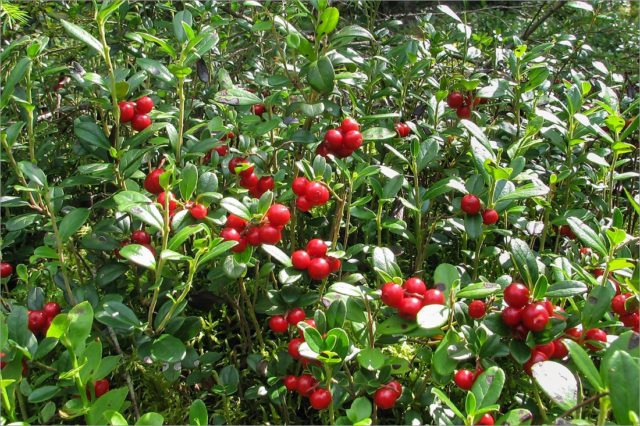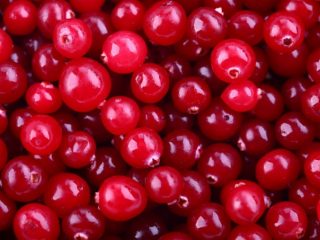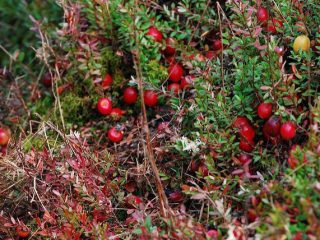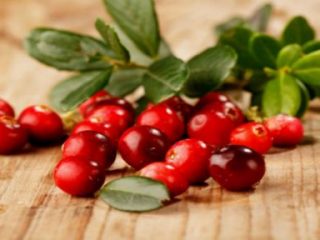Content
Cranberries can be not only a wild berry; they can also be grown at home. Planting and caring for cranberries in open ground has its own characteristics. You can learn about this, as well as how to grow and propagate this plant, and what diseases it suffers from in this article.
Description
Cranberries belong to the Heather family. These are low, creeping shrubs with leathery, evergreen leaves and edible red fruits. These plants most often grow in swamps and swampy lowlands, along the banks of rivers and lakes, as well as in sphagnum coniferous forests. Distribution area: Northern Hemisphere: Europe and Russia, North America.
For cranberries:
- tap roots, on which a fungus lives, the mycelium of which intertwines with the skin of the roots, draws nutrients from the soil and transfers them to the roots;
- leaves are oblong or ovate, on short petioles, dark green above, ashy below, covered with a slight waxy coating;
- the flowers are pink or light purple, the fruits are edible spherical red berries.
The Latin name for cranberries is Oxycóccus, the name of a genus that includes several species. Berries of all types are edible, so you can grow any of them on your plots.
Common cranberry
The common cranberry (or Vaccinium oxycoccos) is native to Eurasia. Sometimes it forms thickets in peat and sphagnum swamps. It is a creeping shrub with thin stems, leaves with a white lower blade, flowers with 4 petals and dark red berries. They are collected for eating and processing into various products, which include this swamp berry.
Small-fruited cranberry
Small-fruited cranberry (or Vaccinium microcarpum) is also a Eurasian species. It differs from the ordinary one in having smaller leaves and fruits.
Large cranberry
Large-fruited or American cranberries (Vaccinium macrocarpon) are native to North America. Due to its large berries, it is grown on an industrial scale in some countries.
How cranberries reproduce
To propagate this garden berry, seeds and cuttings are used. The first method is used mainly in breeding work, and when breeding at home - for propagating a small number of plants that are available. Propagation by cuttings is the main way in which garden cranberries can be propagated for home garden beds.
How to grow cranberries from seeds
To obtain seeds, select large, fully ripe and healthy berries. The seeds are extracted from them: the fruits are crushed, placed in water, and the seeds are selected. They are immediately sown or dried and stored in plastic bags. Before sowing stored dried seeds, stratification is carried out (in a wet mixture of peat and sand) for 3 months at a temperature of 3–5 °C.
The timing of sowing cranberry seeds: fresh - in late summer, dry - in spring. To grow garden cranberries from seeds, use pots, boxes, and bowls. They are filled with high-moor peat, seeds are scattered over the surface and sprinkled with a 2–3 cm layer of sand or a 0.5 cm layer of crushed moss, and then watered. The container is covered with film and placed in a warm place, watered as the top layer of soil dries. Shoots appear 2–3 weeks after sowing.
When garden cranberry seedlings develop 4–5 leaves, they are transplanted into greenhouse beds at a distance of 10 cm from each other. The bushes are kept in the greenhouse throughout the year. Fertilizing – with solutions of ready-made universal mineral fertilizers (dosage – 1 tbsp per 10 l, water with the solution at the rate of 1 liter per 1 sq. m). Watering frequency - once every 2 weeks. Water at the root, rinse the solution from the leaves with clean water to avoid burns.
At the end of summer, the cover is removed from the greenhouse, and before the onset of cold weather, the bed with garden cranberries is mulched with a 5 cm layer of peat and covered with spunbond, under which the young plants overwinter. In the spring, the seedlings are transplanted into a shkolka, where they remain for 1–2 years, and then they are placed in a permanent place. The first harvest from garden cranberries grown from seeds can be obtained 2–3 years after final planting.
Propagation of cranberries by cuttings
In order to propagate plants in this way, you need to cut green cuttings from young shoots at least 10 cm long and plant them in moist soil (a mixture of peat, sand, sawdust and pine needles), mulching it with a peat layer. Pour over and cover with light film.
After 3–4 weeks, the cuttings will take root (rooting rate is almost 100%). In the place where they will constantly grow, they are placed densely in a pattern of at least 10 by 10 cm (this density allows you to get a harvest faster). A month after planting, the young bushes are fertilized for the first time with mineral fertilizers. The first harvest of garden cranberries from plants planted by cuttings can be obtained in the third year after planting, and the next year you can expect abundant fruiting.
Seedlings
Thin creeping cranberry shoots take root well in the ground even without additional help, so this plant is easiest to propagate with such shoots - you need to separate the rooted young shoots and replant them in the beds.
Growing cranberries in the garden
In order to properly grow garden cranberries on your site, you need to take into account all the subtleties of this process.
How to choose a place
Cranberry is considered a cold-resistant and unpretentious plant, but despite this, growing it on private plots is considered a rather labor-intensive task, since it requires the creation of certain conditions for its growth.
Cranberries are lovers of moist soil, so for its cultivation you need to choose exactly the right area: areas with a close supply of groundwater or located in lowlands will be preferable. Soil acidity should be low - 3–4.5 pH. Peat bogs are optimal for garden cranberries, but sandy loam and loam are also suitable.
You should not plant cranberries in an open area; it is much better to place them under trees or near buildings, low fences, so that the sun's rays do not fall on them and strong winds do not dry them out.
Planting cranberries in spring
Cranberries are planted in the spring, as soon as the soil warms up to a depth of 10 cm after the snow melts. If the soil in the selected area is non-acidic, then you need to remove the top layer of soil 20–25 cm deep and instead lay a fertile mixture of humus, forest soil, peat, sand and rotted needles
The holes for garden cranberry seedlings should be 10 cm deep, the distance between them should be from 10 to 20 cm. Each of them should be watered and 1 plant should be planted in them. There is no need to compact the soil around planted cranberry bushes.
Planting cranberries in autumn
Planting is usually not done in the fall, but if this must be done, the plants must be planted at least a month before the onset of cold weather so that they take root. And also in the fall you can prepare the beds for spring planting.
Cranberry care
Caring for this plant has its own characteristics that you need to know about when growing it at home.
in spring
In the spring, when new cranberry shoots begin to grow, you need to do pruning: thin out the shoots, loosen the soil and feed the plants with complex mineral fertilizer. It is advisable to mulch the soil around young bushes that have not yet closed. Next to the cranberry, you can plant honey-bearing spicy plants, for example, savory or oregano, which will subsequently attract bees to pollinate the cranberry flowers.
In summer
In summer, especially in the heat, it is important to ensure that the soil in the beds with bushes does not dry out and to water them in a timely manner. You also need to weed on time. weedsso that they do not interfere with the cranberries growing.
in autumn
At the beginning of autumn, in September or the next month - in October, you can already harvest red berries. With good care, garden cranberries can produce 1 kg of fruit per 2 square meters. m of planting area. For the winter, the bushes need to be covered with a layer of peat or other plant-based insulating material so that they do not freeze out during the cold winter months.
Watering
Sufficient soil moisture, especially in hot weather, is a necessary condition for normal growth and development of plants. Therefore, cranberries need to be watered frequently and abundantly. You can add a little citric or acetic acid to the water to acidify the soil. The crop needs to be fed 2 times a month with complex mineral fertilizers.
Cranberry pruning
This agrotechnical measure is necessary for the formation of plant bushes of the correct shape.
What time to prune
Garden cranberry bushes need to be trimmed in May, when the shoots have grown to a sufficient length.
Spring pruning
To obtain a high yield of garden cranberries, you need to cut off the creeping shoots on it, thus stimulating the regrowth of young vertical ones. It is on them that the plant bears fruit.
Autumn pruning
In general, pruning should be done in the spring rather than in the fall. In autumn, bushes are pruned only if necessary. The form of pruning is similar to that in spring.
Cranberry diseases with description
If you follow the rules of agricultural technology, garden cranberries are distinguished by excellent “health,” but they can still get sick. It is important to detect the disease on time, and for this you need to know the characteristic signs that it manifests itself.
Monilial burn
This is a fungal disease that affects the tops of young shoots: they wither, then turn brown and dry out.In rainy weather they become covered with a coating of fungal conidia. When buds appear on garden cranberries, the damage spreads to them, then to the flowers and ovary. As a result, the flowers dry out and the fruits continue to grow, but rot. Control measures - spraying with copper oxychloride or Ronilan fungicides, Topsin M, Bayleton, Ditan.
Cranberry terry
This is a dangerous viral disease caused by mycoplasma microorganisms. The shoots on the affected plants grow greatly, they stop bearing fruit, and those fruits that set before the development of the disease turn out to be deformed and small. There is no cure for this virus, so diseased plants must be uprooted and burned.
Ascochyta blight
With this disease, dark brown round spots appear on the leaves and shoots of cranberries, and the tissue underneath them begins to crack over time. Treatment – treatment with copper oxychloride, Fundazol, Topsin M.
Pestalocy
This disease affects the shoots, leaves and fruits of garden cranberries. At first, dark brown spots form on them, then they become gray with dark edges, and over time they gradually merge with each other. The shoots bend in a zigzag shape and the leaves fall off. The drug for treatment is copper oxychloride.
Gibber spot
With this disease, premature massive leaf loss occurs, which greatly weakens the bushes. Signs of spotting - in early August, red-brown small spots appear on the leaves, then they become shapeless, chlorotic with a dark rim, in the center of which you can see the fruiting bodies of the fungus. Drugs for treatment - copper oxychloride, Fundazol, Topsin M.
Cytosporosis
This is black rot that appears on berries.Control measures are preventive spraying in spring and autumn with copper preparations and fungicides Topsin M, Fundazol.
Snow mold
This disease develops in early spring. The buds and leaves of the cranberries become red-brown, and yellowish mycelium of the fungus appears on them. By the end of spring, the leaves turn ashy and fall off. If there is no treatment, the plant may die. Control measures include autumn spraying with a solution of Fundazol and freezing the soil during the winter cold.
Phomopsis
This is a disease in which the ends of cranberry shoots dry out without previous wilting. The leaves first turn yellow, then orange or bronze. Dirty gray spots appear on the shoots, which then turn into ulcers, flowers and berries turn brown. Prevention measures - early spring treatment with copper preparations.
Botrytis
This is a gray fluffy rot that appears on the shoots, green leaves and flowers of plants on humid days. Treatment is medications containing copper.
Red spot
A fungal disease that causes cranberry shoots to become deformed and die. Buds, flowers and their stalks become pinkish. The leaves emerging from the affected buds resemble small roses. Treatment is copper-containing preparations or fungicides.
Cranberry pests
Pests that may appear on garden cranberries include lingonberry moth, gypsy moth, apple scale insect, cabbage cutworm, and heather moth.
Prevention of the appearance of insects on cranberry bushes - compliance with agrotechnical cultivation rules. In order not to miss the moment of the appearance and reproduction of pests, you need to regularly inspect the plants, and if detected, treat them with agrochemicals.
Combination of cranberries with other plants
Since garden cranberries prefer acidic soil, garden crops such as tomatoes, cabbage, cucumbers, etc. cannot be planted next to them. But you can plant another no less tasty and healthy berry - lingonberries, which love the same conditions as cranberry.
Preparing for winter
Despite the fact that this crop is cold-resistant, the bushes for the winter need to be sprinkled with peat, fallen tree leaves, sawdust, or covered with any other mulching material. In the spring, with the onset of constant warmth, remove the shelter.
Conclusion
Planting and caring for cranberries in open ground is not difficult, but has its own characteristics. If you follow the advice given in this article, you can grow plants on your plot that will delight you with their harvest for many years.
https://www.youtube.com/watch?v=noM5BaoGYX0
